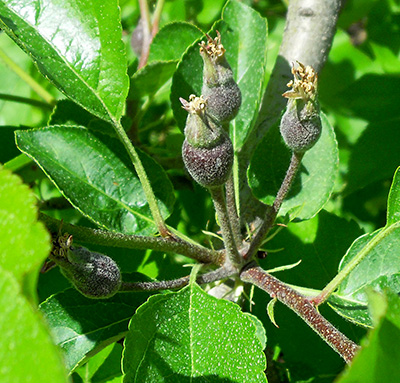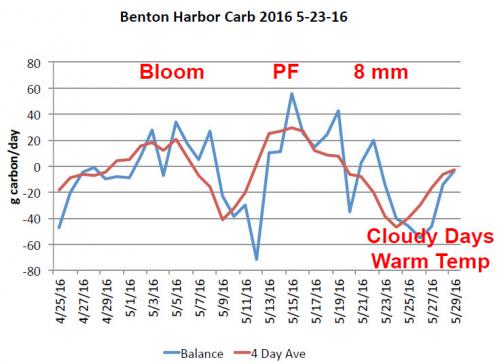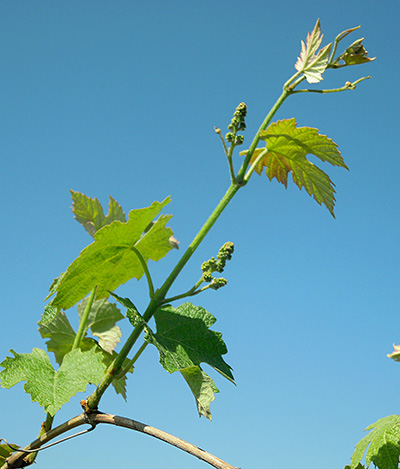Southwest Michigan fruit regional report – May 24, 2016
A warm, dry week moved everything along quickly. Insect activity increased over the weekend.

Weather
Last week was generally dry. High temperatures were normally in the 70s inland and 60s close to the Lake. Overnight lows were in the 30s and 40s. The big nighttime drop in temperature indicated the air was very dry. A frost Thursday, May 19, caused some growers to run their sprinklers, but it did not appear the temperatures dropped below freezing and no damage was reported. High temperatures over the weekend were near 80 degrees Fahrenheit and this warm weather is forecast to continue through the week. Low temperatures will be in the 60s indicating moist air. There is a chance of thunderstorms starting late on Tuesday, May 24, with a good chance on Wednesday and Thursday through the weekend.
The trees have leafed out and with the dry heat, the topsoil is becoming dry. Growing degree-day (GDD) heat accumulations last week were double the previous weeks’ totals. We can expect heat accumulations to be even higher this week with the hot weather. For example, with a high of 80 and a low of 65, the average temperature for the day is 72.5 F with 30 GDD42, 27 GDD45 and 22 GDD50 every day.
Southwest Michigan GDD summary from Jan. 1 - May 22, 2016 |
|||
|---|---|---|---|
|
Station |
GDD 42 F |
GDD 45 F |
GDD 50 F |
|
Benton Harbor (SWMRC) |
739 |
573 |
356 |
|
Lawton (Lawton) |
775 |
603 |
378 |
|
Fennville (TNRC) |
599 |
453 |
266 |
|
Average for the region |
685 |
526 |
322 |
|
Accumulation last week |
107 |
88 |
59 |
Tree fruit
Stone fruit are generally out of the shuck. Apple bloom continues for late blooming varieties and bloom on 1-year-old wood. Warm, rainy periods this week could be significant infection period for apple scab, cherry leaf spot and other diseases. Insect activity increased last week with the warm temperatures. Plum curculio egglaying and feeding scars were found Monday morning, May 23. Growers should provide insecticide protection for stone fruit that have emerged from the shuck. Trap catch numbers for many moth pests jumped with the warm weather last week. Leaf feeding holes by flea beetles, leafrollers and green fruitworm are becoming easier to find.
Apricot fruit are 20 to 25 millimeters in diameter. Exposed fruit should be protected from plum curculio and scab.
Peaches are 8 to 12 millimeters in diameter. In general, the crop potential looks good. Oriental fruit moth numbers are high in many sites. Biofix, the first sustained flight of oriental fruit moth, was set as Monday, April 25, based on trap catches at the Trevor Nichols Research Center trap line. Michigan State University’s Enviro-weather oriental fruit moth model indicates egglaying is underway and egg hatch has begun. Sprays to control the larvae should be applied this week if not done last week. Rains favor bacterial spot infection of young leaves and fruit. Peach varieties prone to rusty spot should be protected until pit hardening. It is too late to treat peach leaf curl; infected leaves will fall off.
Sweet cherries are 10-12 millimeters in diameter. Pit hardening has begun on the largest fruit. Sweet cherries are susceptible to brown rot at all times, so MSU Extension advises growers to protect the fruit during warm wet periods. Cherry leaf spot infects cherry leaves through the stomates and, once unrolled, the leaves are always susceptible to infection.
Tart cherries are emerging from the shuck. There are two distinct sizes. The largest cherries are 6 to 8 millimeters in diameter. Fruit should be protected from plum curculio. Leaves are vulnerable to leaf spot. Growers have been applying protectant fungicides for cherry leaf spot.
Japanese plums are 12 to 15 millimeters in diameter. Fruit set varies from variety to variety and between sites. Bacterial spot symptoms can be found on more susceptible varieties.
European plums are 9 to 11 millimeters in diameter. Plums need to be protected against black knot from first bloom until second cover. See “Controlling black knot in Michigan” for more information. Plum curculio will lay their eggs in exposed fruit when temperatures are in the 70s.
Apples orchards are generally past bloom, but late blooming varieties are still blooming. In some blocks there is a heavy bloom on 1-year-old shoots. Fruit sizes vary from 7 to 17 millimeters in diameter. Warm weather conditions this week increase the effectiveness of apple thinning sprays. With most of the fruit in the 8- to 12-millimeter size range, thinning sprays will be most effective this week. Growers need to assess their crops. Thinning sprays applied during this hot weather may over-thin the crop. Growers will want to reduce rates on materials like NAA or perhaps wait until the high level of stress has passed.

Most apple fruitlets are 8 to 12 millimeters in diameter, the ideal range for fruit thinning.
Below is the Carbohydrate Demand Balance Model for southwest Michigan. Apples become easier to thin as the balance falls below zero; levels of -40 to -60 are considered ideal. Levels below -80 should be avoided and you probably shouldn’t thin with extreme stress. Cloudy conditions reduce photosynthesis and reduce the balance. The cloudiness and projected rains this week will have a large impact on thinning. If it is cloudy all day, thinners will be more effective. If it is mostly sunny with passing thunderstorms, then the thinners will be less effective.

The Carbohydrate Demand Balance Model for southwest Michigan. Apples become easier to thin as the balance falls below zero on the left-hand axis. Levels of -40 to -60 are considered ideal. Levels below -80 should be avoided and you probably shouldn’t thin with extreme stress. The "4 day average" is the average of a given day and the next three days forecast in the future. Cloudy conditions reduce photosynthesis and reduce the balance.
With the large numbers of open flowers, growers need to be aware of fire blight. Newly opened bloom is susceptible to fire blight infection with rain during bloom and temperatures above 65 F. According to the Enviroweather fire blight model, symptoms from the April 25 fire blight infection period in parts of Berrien County should appear this week.
Apple scab ascospores numbers continue to decline from the peak releases in late April. The Enviroweather apple scab model indicated all apple scab spores have matured in most areas. Not all the spores have been discharged. There will be more spores discharged with the upcoming rains. Coverage to prevent primary scab generally continues into early June. Growers should scout their orchards and look for scab lesions on the leaves.
Codling moths were caught at several locations this past week, marking biofix and the beginning of the first generation flight. Petal fall is the time to scout for larvae and mines of spotted tentiform leafminer to determine the need to spray. Leafroller larvae are feeding on the shoot tips and leaves in blocks that did not receive prebloom insecticide sprays.
Pears fruit are 10 to 15 millimeters in diameter. Pear psylla adults are flying. The post-bloom period is often used for psylla control. New leaves are tender and can easily absorb systemic materials that kill psylla as they feed. Pears also need to be protected against pear scab and fire blight.
Small fruit
Juice grape shoot growth is rapid, and shoots are 6 to 12 inches with flower clusters elongated and beginning to separate. Hybrid wine grapes vary, but the most advanced have similar development with leaves unfolding, exposing the flower clusters. Vinifera grapes are at 3- to 5-inch shoots. As of now, shoot and leaf tissue are vulnerable to infection by powdery mildew, downy mildew, black rot and Phomopsis. Fungicides to control these diseases should be applied before upcoming rains.
Grape berry moth flight is occurring, but first generation egglaying is a few weeks away. Growers and scouts planning to use the Enviro-weather grape berry moth model should note nearby wild grapes in order to record bloom date for use in the model.

Shoot growth in juice grapes has been rapid and flower clusters are elongated and starting to separate.
Blueberry bloom continues. Fields away from Lake Michigan are past full bloom and into petal fall. Fields closer to Lake Michigan are delayed in bloom timing because of cooler temperatures close to the cool lake. Bloom is very heavy throughout the region. Growers applied mummy berry sprays to protect the flowers during bloom. Growers should avoid spraying in the middle of the day when bees are foraging on the bloom. At petal fall, anthracnose becomes a concern and the preferred fungicide changes to include action against anthracnose, mummy berry and phomopsis.
Cherry fruitworms were trapped last week in many sites. This is up from single moths in a few traps the previous week, so the warm weather has given us a strong biofix early last week. Cranberry fruitworms were also caught before and after the weekend, indicating this flight has begun. Grower can use the Enviro-weather cranberry fruitworm model to focus their sprays for these pests. See “Fruitworm control in blueberries” for more information.
There are several bee-safe materials that can be used during bloom. Wait until the end of bloom and the removal of bee hives before applying harsher materials that will kill the bees. Be aware that even though some materials are rated as bee-safe and will not kill adult bees, that does not mean they have no effect on the brood or hive heath if carried back to the hive. In any case, growers should not be spraying any materials during the day when bees are foraging on the bloom. Sprays should be applied in the early morning, late afternoon or at night when the field force of the bee hive is in the hive and not in the field.
Strawberry bloom continues. The primary flowers have been pollinated and are drooping down. Fungicides to control fruit rots and leaf diseases are the primary concern in strawberries. Growers should avoid spraying in the middle of the day when bees are foraging the bloom. Common strawberry leaf spot is the chief concern. If the weather is wetter than predicted, angular leaf spot could be a problem. Some growers ran sprinklers Thursday morning, May 19, to prevent frost damage to the exposed flower buds.
Bramble growth continues. Primocanes of fall bearing raspberries are growing well. Primocanes are 18 inches tall. In summer bearing raspberries, the flower buds are separating in the clusters and bloom is beginning in early varieties.
Cranberry uprights are about 3 inches long. Flower buds are not yet visible.
Upcoming meetings
Grape growers’ pre-bloom IPM meeting is tomorrow, May 25, at Cronenwett Farms from 3 to 6 p.m. at 70121 28th St., Lawton, MI. Charge is $10 per person with a light meal afterwards. Walk-ins are welcome, but please pre-register so we have enough food. Two restricted-use pesticide credits are available. Call or email Brad Baughman at 269-927-5674, ext. 4012 or baughm30@anr.msu.edu.
There is no Monday Fruit IPM meeting next week on Memorial Day, May 30. Our next Monday fruit IPM meeting in southwest Michigan is June 6 at Fruit Acres Farms located at 2559 Friday Road, on the northeast corner of Friday and Carmody Roads, south of Coloma, at 5 p.m. Two Michigan pesticide applicator recertification credits are available at these meetings.
See also:
- Management of bacterial spot on peaches and nectarines
- Fungicide considerations for cherry leaf spot control at first cover
- Controlling cherry leaf spot in orchards with early infections
- Effectively controlling plum curculio in stone and pome fruits
- Controlling black knot in Michigan
- Apple thinning points for 2014
- How to use Enviro-weather’s apple scab tool
- SDHI fungicides for apple scab management
- Update on resistance to strobilurin fungicides in the apple scab fungus in Michigan
- Plan ahead to manage pear psylla
- Many materials available for pear psylla management
- Protect new grape shoots from early-season fungal diseases
- Mummy berry management in blueberries during bloom
- Fruitworm control in blueberries
- Use anthracnose fruit rot prediction model to assess risk of infection.
- Why Intrepid has use restrictions and advice for complying
- Managing blueberry stem gall wasp
- Watch out for angular leaf spot in strawberries



 Print
Print Email
Email